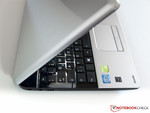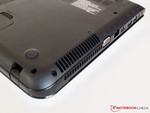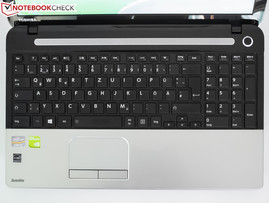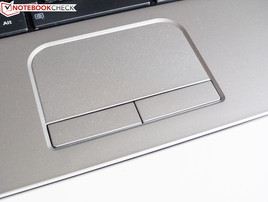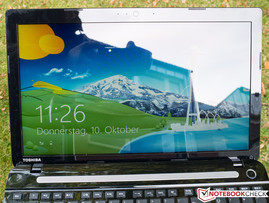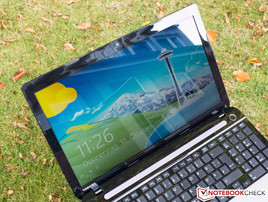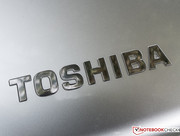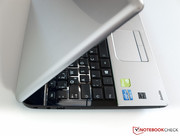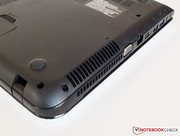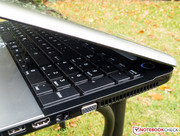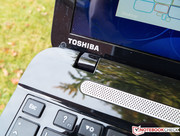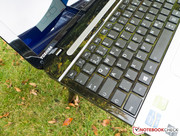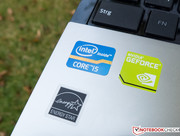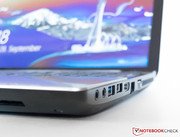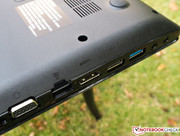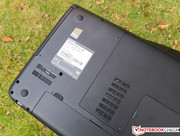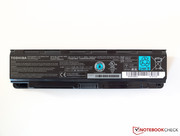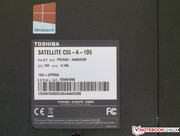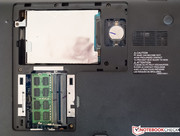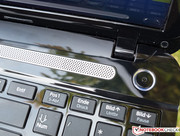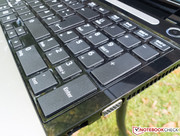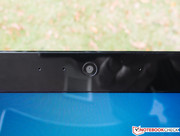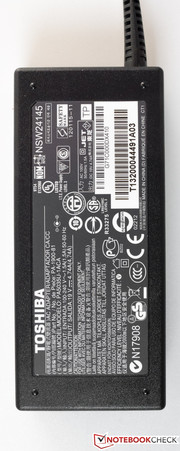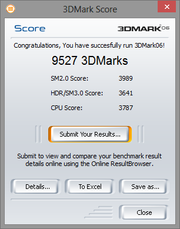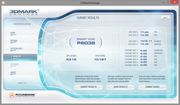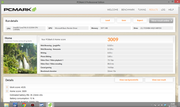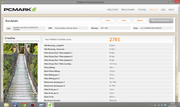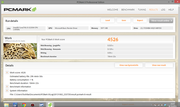Review Toshiba Satellite C55-A-1D5 Notebook

For the original German review, see here.
An Intel Core i5-3230M (2x 2.6 - 3.2 GHz, Hyperthreading, TDP: 35 W) alongside a dedicated Nvidia GeForce GT 740M graphics solution with 2 GB of memory make Toshiba's Satellite C55-A-1D5 a multimedia laptop. Our benchmarks prove that this combination also allows playing current and graphically demanding games smoothly in medium or sometimes even higher presets.
For this test report, we used Acer's Aspire V3-571G-73614G50Makk and Asus' A56CB-XX053H, both with 15.6-inch screens, for comparison. The first device features Intel's Core i7 3610QM (4x 2.3 - 3.3 GHz, TDP: 45 W) entry-level quad-core, which is based on the Ivy Bridge architecture just like Intel's Core i5-3230M, while the performance of Nvidia’s GeForce GT 640M graphics solution is lower than that of the Toshiba laptop. Asus' A56CB sports a runtime-friendly but slower Intel Core i3-3217U ULV dual-core (2x 1.8 GHz, Hyperthreading, TDP: 17 W) and the same graphics chip as our review sample. The other equipment in the Acer and Asus is identical with the Toshiba and both are also available for below 700 Euros (~949). The portability factor is also noteworthy. Both the Toshiba and the Asus weigh 2.3 kg (~5.1), which is typical in this category, but the V3 is heavy at 3.2 kg (~7.1) on the scales.
Our in-depth review will reveal how Toshiba's C55-A-1D5 fares in games, multimedia and in office work based on numerous benchmarks.
Case
The review sample's casing tries to add a few visual highlights but a high-quality impression is not produced due to the cheap-looking plastic. The wrist rest, touchpad and display's back feature a glossy silver color and the area below the keyboard up to the lid and the display's bezel have a black piano paint surface. The Toshiba's underside is matte black and provides a non-slip grip in the unlikely case of transportation.
With a bit of effort the plastic casing can be warped to a slight extent but this does not produce any noises. Particularly the base unit's front left area is a bit flexible. The lid is not thin and ensures a certain degree of rigidness. Even pressing the lid's back firmly with a thumb does not cause image distortions. The hinge keeps the lightly rocking screen securely in position but it is pulled so tight that both hands are needed for opening the laptop. The maximum opening angle is 135°. Except for the glossy black surfaces, the Toshiba is quite resistant against fingerprints, which are only noticed in certain lighting conditions.
As to build, minor inaccuracies were noticed, for example a protruding edge of the base unit's lower part that might sometimes be unpleasant for the palm.
Connectivity
There is no need for adapters because the interfaces on Toshiba's C55-A-1D5 are all full-sized. The port distribution is not designed for right-handed users who prefer using an external mouse. Toshiba places most interfaces on the right front where cords and peripherals, such as USB flash drives, might prove to be interfering. The DVD drive is in the front left area and its eject button is difficult to find. A USB 2.0 port and the power socket are behind that.
The configuration with the most important interfaces exactly complies with the standard that can be expected in this category. The buyer will usually have to dig deeper in his pockets for extras such as a DisplayPort or an eSATA.
Communication
An Atheros L1C PCI-E Ethernet controller can be used for cabled Gigabit LAN. It is just as reliable as the Realtek RTL8188E Wireless module found in many laptops. The Wi-Fi transmission rates consistently scraped the limit of the author's individual DSL line setup at a distance of about 10 meters (~33 feet) and through two brick walls. Smooth browsing would still be possible even in conditions that are more unfavorable. Bluetooth is not available.
Accessories
A low price normally equals few accessories. Toshiba's C55 is no exception. There is nothing in the box besides a quick start guide and the compulsory power supply. Toshiba installs a Recovery Center for creating backup media for system recovery. A trial version of McAfee Internet Security Suite is also installed but it starts to demand a fee-based registration after only a few days, and we therefore replaced it with Microsoft's Security Essentials for the test. Otherwise, there are a few small tools from Toshiba, such as a media player.
Maintenance
Toshiba secures the maintenance cover with one screw that can only be removed and reinserted with brute force. This inevitably leads to the feeling that something might be damaged. The cover allows accessing the hard drive, memory slots (one empty), and the motherboard battery. The fan cannot be accessed this way.
Warranty
Toshiba’s standard one-year carry-in warranty on its laptops is included. Various upgrade options can be found on www.toshiba.com/us/serviceplans.
Input Devices
Keyboard
The keyboard's layout largely corresponds to that of a desktop keyboard, only that its flat black keys primarily feature a spongy pressure point that will soon let the user call for an external unit. It is unusual that the function keys in the uppermost row control functions like brightness and volume when pressed alone. The blue FN key has to be pressed additionally to use the assignments as known from other keyboards. We find the piano paint used between the keys unpractical because they are soon covered with fingerprints that can only be removed inconveniently.
Touchpad
In our opinion, the pleasantly subtly textured Synaptics PS/2 Port touchpad could be larger particularly since there would have been enough room. It is not completely touch-sensitive up to its edges and features clattering keys that want to be pressed in the center. The usual gestures using up to three fingers are detected reliably. However, the touchpad annoyed us during the test due to an occasional, non-reproducible freezing of the mouse cursor. This was not observed when using an external mouse.
The author's palms (medium-sized male hands) did not fit on the too small wrist rest while typing. Instead, they were propped on the casing's rather jagged edge, which was unpleasant in the long run.
Display
The 15.6-inch (diagonal) screen with a 16:9 aspect ratio has a resolution of 1366x768 pixels, which adds up to a modest pixel density of approximately 100 ppi. Although TN screens, like in the Toshiba, are known for their fairly poor viewing angles and moderate contrasts, the manufacturer did not pick one from the lower shelf. The model fares well in the category comparison. The maximum possible brightness of 247 cd/m², which is not reduced in battery mode, contributes to that and places the C55-A-1D5 in the upper midfield. The pleasingly low black value of 0.36 cd/m² and decent contrast of 696:1 look even better in the comparison of multimedia laptops. Subjectively, we found black quite saturated providing that the ideal vertical viewing angle was found. In return, the focus could be better; writing often looked a bit blurry. However, that was not noticed in games or movies.
Asus' A56CB-XX053H cannot quite match the review sample's brightness. We measured a maximum of 216 cd/m² and the contrast of 545:1 is rather middling. Our Acer Aspire V3-571G-73614G50Makk is only marginally darker than the Asus but lags behind the competition with a contrast ratio of only 132:1.
| |||||||||||||||||||||||||
Brightness Distribution: 81 %
Center on Battery: 247 cd/m²
Contrast: 686:1 (Black: 0.36 cd/m²)
ΔE ColorChecker Calman: 6.08 | ∀{0.5-29.43 Ø4.77}
ΔE Greyscale Calman: 7.7 | ∀{0.09-98 Ø5}
51.2% AdobeRGB 1998 (Argyll 1.6.3 3D)
53.7% AdobeRGB 1998 (Argyll 3D)
73.5% sRGB (Argyll 3D)
53.7% Display P3 (Argyll 3D)
Gamma: 2.41
CCT: 9379 K
The screen in Toshiba's laptop covers 51.2% of the AdobeRGB color space and is thus in the upper midfield of the multimedia laptop category. The subjectively good color reproduction confirms this but will in no way suffice for professional image editing.
The ascertained color deviations are within limits with an average DeltaE (2000) rate of 6. The generally overemphasized blue hues however cause a light color cast that particularly comes through in medium-light gray hues. The bluish cast conveys a slightly cool image impression.
The screen's maximum brightness is high enough for working outdoors. However, the extremely reflective surface is very distracting. Bright light from the back should be avoided because working is otherwise agonizing. On the other hand, it is not a portable office laptop; the device has clearly been designed for indoor use.
The screen’s viewing angle is unusually stable considering the TN technology. The screenshot below shows that changing the horizontal viewing angle by 45° only causes a slight image deviation. The user will have to expect deteriorating contrasts when looking down on the screen. Inverting has to be accepted in rare cases where the screen is above the viewing horizon or the lid is tilted too far to the back. We have observed a worse job in the very low-budget office laptop category and higher price ranges alike.
Performance
The installed Intel Core i5-3230M (2x 2.6 - 3.2 GHz) and its two physical cores as well as Hyperthreading alongside Nvidia’s GeForce GT 740M mobile midrange GPU forges a solid though not exactly future-proof gaming and multimedia array. The CPU is based on the Ivy Bridge generation and is built in the 22-nanometer process (former generation Sandy Bridge: 32 nanometers). The GPU was launched on the market in early 2013 and exists in two versions, one of which (GK107) features a 128-bit wide memory bus. The other version, based on the GK208 architecture and that is installed in Toshiba's C55, has a faster clock rate but only a 64-bit bus. Both 740M versions work with a DDR3 memory.
Processor
Well-parallelized applications and games are represented by Cinebench R10 and R11.5. Although they benefit from the fact that Intel's dual-core Core i5-3230M can process up to four threads at the same time owing to Hyperthreading, genuine quad-cores, such as Intel's Core i7-3610QM (Acer Aspire V3-571G-73614G50Makk), are easily about twice as fast. However, it also has a 10 Watt higher TDP of 45 Watts. Intel's Core i3-3217U in Asus' A56CB-XX053H with a fixed clock of only 1.8 GHz and the ULV CPU typical TDP of 17 Watts lags behind the review sample's processor by up to 47%.
The high maximum clock of 3.2 GHz ensures enough single-thread power when only one core is loaded. It is achieved via Turbo Boost. 3.0 GHz is the limit when both cores are loaded. The CPU's base clock is 2.6 GHz. The more energy-efficient ULV CPUs with a TDP of 17 Watts mostly stand out because of much lower base clocks.
The CPU in the review sample fits well in an affordable multimedia laptop and would also look good in a swift office computer - but with a screen diagonal of at least 14 inches and of course without a dedicated graphics chip.
The CPU power in the Toshiba, which is not limited in battery mode, is virtually identical with that of other laptops based on the same platform. We did not observe thermal throttling in the one-hour stress test using Prime95 + FurMark.
| Cinebench R10 | |
| Rendering Multiple CPUs 64Bit (sort by value) | |
| Toshiba Satellite C55-A-1D5 | |
| Asus A56CB-XX053H | |
| Acer Aspire V3-571G-73614G50Makk | |
| Rendering Single CPUs 64Bit (sort by value) | |
| Toshiba Satellite C55-A-1D5 | |
| Asus A56CB-XX053H | |
| Acer Aspire V3-571G-73614G50Makk | |
System Performance
Among others, we use the scores from the PCMark 7 and PCMark Vantage benchmarks to assess system performance. They simulate a wide range of applications and operation scenarios, and sometimes even demand the graphics unit. Whereas the Asus is inferior in raw CPU performance, its total PCMark 7 score is only about 10 percent lower than the Toshiba. The four physical cores in the Acer do not bring any advantages and the laptop is approximately on a par with the review sample. Acer's Creativity Score (PCMark 7) is even 45% lower compared with Toshiba's C55-A-1D5, which is due to the weaker Nvidia GeForce GT 640M midrange GPU. PCMark 7's Entertainment benchmark looks different and Acer's quad-core can outperform the Toshiba by 18% while Asus' A56CB (ULV) only lags behind the review sample by 7%.
PCMark Vantage illustrates a wider spread of scores between the three laptops. Acer's total score is 54% higher than that of the Toshiba while Asus' A56CB comes in last with minus 17%.
| PCMark Vantage - 1024x768 Result (sort by value) | |
| Toshiba Satellite C55-A-1D5 | |
| Asus A56CB-XX053H | |
| Acer Aspire V3-571G-73614G50Makk | |
| PCMark Vantage Result | 6124 points | |
| PCMark 7 Score | 2544 points | |
| PCMark 8 Home Score Accelerated | 3009 points | |
| PCMark 8 Creative Score Accelerated | 2781 points | |
| PCMark 8 Work Score Accelerated | 4526 points | |
Help | ||
Storage Devices
The hard drive from Toshiba dubbed MQ01ABF050 and with a gross capacity of 500 GB has an average sequential read rate of 86 or 98 MB/s and thus places itself in the midfield for a 5400-rpm drive. The same HDD installed in other laptops is at most 7% faster. Very swift drives with this speed can achieve an up to 25% higher transfer rate. Only a few 7200-rpm HDDs and of course SSDs are faster.
The hopeless inferiority of conventional hard drives in contrast to SSD becomes obvious in the Toshiba's 4k rates, such as when small and random data blocks have to be read quickly. SSDs habitually manage rates of over 20 MB/s here.
An overview of the benchmark scores for many hard drives and SSDs can be found in our FAQ section.
Graphics Card
The installed DirectX 11-capable Nvidia GeForce GT 740M with 2 GB of dedicated DDR3 memory is also a decisive factor for the gaming suitability of Toshiba's C55-A-1D5. The narrow 64-bit memory bus faces the quite high GPU and memory clock of 980 to 1033 MHz or 900 MHz in the newer GK208 version of the chip installed here. It is owing to Nvidia’s Optimus technology that the processor-integrated, energy-efficient Intel HD 4000 is enabled during very low demand, so primarily in the 2D field.
The performance score of Toshiba's laptop is 13% below that of the Asus and 7% below the Acer Aspire in 3DMark 11. It becomes obvious here that the old version of the GT 740M, based on the GK107 chip with a twice as wide 128-bit memory bus, is faster as soon as more bandwidth is required despite its lower clock. This looks the same in 3DMark Vantage. The Asus device achieves a 32% higher score than the review sample in the GPU benchmark and the Acer takes an 18% lead. Toshiba's laptop reaches full power even on the go in battery mode.
| 3DMark 06 Standard Score | 9527 points | |
| 3DMark Vantage P Result | 6038 points | |
| 3DMark 11 Performance | 1793 points | |
| 3DMark Ice Storm Standard Score | 33331 points | |
| 3DMark Cloud Gate Standard Score | 4037 points | |
| 3DMark Fire Strike Score | 965 points | |
Help | ||
Gaming Performance
384 Shaders ensure that all games we tested ran smoothly in at least medium settings. The power was even sometimes enough for high settings (Bioshock Infinite). The exception was the extremely demanding Company of Heroes 2 that still just ran smoothly in minimum settings. More details can be found in the chart below and in our benchmark list with many mobile graphics cards and in-depth information about the games we used.
| Toshiba Satellite C55-A-1D5 GeForce GT 740M, 3230M, Toshiba MQ01ABF050 | Acer Aspire V3-571G-73614G50Makk GeForce GT 640M, 3610QM, Toshiba MK5059GSXP | Asus A56CB-XX053H GeForce GT 740M, 3217U, Western Digital Scorpio Blue WD5000LPVT | |
|---|---|---|---|
| Anno 2070 | 4% | 15% | |
| 1920x1080 Very High Preset AA:on AF:4x (fps) | 15 | 15 0% | 18 20% |
| 1366x768 High Preset AA:on AF:2x (fps) | 30 | 30 0% | 35 17% |
| 1366x768 Medium Preset AA:on (fps) | 49 | 50 2% | 57 16% |
| 1024x768 Low Preset (fps) | 105 | 119 13% | 111 6% |
| Battlefield 3 | 10% | 17% | |
| 1920x1080 ultra AA:4x MS AF:16x (fps) | 8.1 | 11 36% | 12 48% |
| 1366x768 high AA:- AF:16x (fps) | 25.2 | 25 -1% | 31 23% |
| 1366x768 medium AA:- AF:4x (fps) | 31.8 | 33 4% | 34 7% |
| 1024x768 low AA:- AF:2x (fps) | 47.1 | 48 2% | 42 -11% |
| Tomb Raider | 10% | ||
| 1920x1080 Ultra Preset AA:FX AF:16x (fps) | 10.8 10.8 10.8 | 10.8 0% | |
| 1366x768 High Preset AA:FX AF:8x (fps) | 23.3 23.3 | 31.8 36% | |
| 1366x768 Normal Preset AA:FX AF:4x (fps) | 43.1 43.1 | 53.6 24% | |
| 1024x768 Low Preset (fps) | 89.6 89.6 | 70 -22% | |
| Total Average (Program / Settings) | 7% /
7% | 14% /
14% |
| low | med. | high | ultra | |
|---|---|---|---|---|
| Total War: Shogun 2 (2011) | 46 | 37 | 13 | |
| Battlefield 3 (2011) | 47.1 | 31.8 | 25.2 | 8.1 |
| Anno 2070 (2011) | 105 | 49 | 30 | 15 |
| Tomb Raider (2013) | 89.6 | 43.1 | 23.3 | 10.8 |
| BioShock Infinite (2013) | 68.4 | 37 | 30.7 | 9.2 |
| Company of Heroes 2 (2013) | 28 | 21 | 13 | 5 |
Emissions
System Noise
The relatively powerful hardware foundation produces quite a bit of waste heat during load, which has to be discharged from the casing. The fan copes with this task easily in every situation as can be seen based on the casing's moderate temperatures.
The slowest of the four fan speeds does not produce more than a just audible noise and is sufficient for office work and browsing. The noise level is in the upper midfield of multimedia laptops when full load is induced by a game. The fan can still be heard at a distance of five meters (~16 feet) but is not annoying because it does not generate a high-pitched buzzing sound or other background noises.
Noise level
| Idle |
| 32.5 / 32.5 / 32.5 dB(A) |
| HDD |
| 33.2 dB(A) |
| DVD |
| 36.7 / dB(A) |
| Load |
| 35.3 / 43 dB(A) |
 | ||
30 dB silent 40 dB(A) audible 50 dB(A) loud |
||
min: | ||
Temperature
Thanks to the sufficiently strong cooling, the surface temperatures remained inconspicuous even during load and were never noticed adversely. The warmest spot was found in the on/off button's area where the main vents are located and it just surpassed body temperature with 39 °C (102.2 °F) on the underside. The C55-A-1D5 belongs to the cooler laptops in the category comparison. It can also be used on the lap because the heat is discharged from the casing's side.
The CPU cores reached a maximum of 88 °C (190.4 °F) in the stress test, which is within the tolerance range. This also applies to Nvidia’s GeForce GT 740M that did not exceed 65 °C (149 °F).
(+) The maximum temperature on the upper side is 38.1 °C / 101 F, compared to the average of 36.9 °C / 98 F, ranging from 21.1 to 71 °C for the class Multimedia.
(+) The bottom heats up to a maximum of 39.2 °C / 103 F, compared to the average of 39.2 °C / 103 F
(+) In idle usage, the average temperature for the upper side is 26.7 °C / 80 F, compared to the device average of 31.3 °C / 88 F.
(+) The palmrests and touchpad are reaching skin temperature as a maximum (33 °C / 91.4 F) and are therefore not hot.
(-) The average temperature of the palmrest area of similar devices was 28.7 °C / 83.7 F (-4.3 °C / -7.7 F).
Speakers
The speakers are hidden behind a plastic grille above the keyboard. They produce a sound that does not allow a differentiated analysis. No matter whether movies, music, games or system sounds, they are all almost acoustic torture in slightly higher volumes. The reason for this is that the speakers cannot render lower frequencies besides the unreasonably emphasized mids and trebles. There is simply no audible sound below approximately 500 Hz!
Bass that can be called bass is rare in laptops. However, low ranges are only characterized by a kind of click noise. Instruments are generally difficult to identify and both dynamics and the impression of surround sound is absent. It sounds different when the Toshiba is connected to the sound system at home or good headphones are used. Then there is no reason for complaint. It is just important to switch to the current player in the DTS SoundManager.
The manufacturer probably thought that the laptop's target group will prefer using headphones from the outset but every user occasionally relies on the installed speakers. Most contenders prove that a better job is possible even in this price range.
Energy Management
Power Consumption
When the review sample is compared with other multimedia laptops featuring the same screen size, the consumption rates are located in the better third in both a deactivated state and in standby. The idle consumption is average. However, the load consumption strikes in a negative sense, particularly during full load. Toshiba's Satellite C55-A-1D5 belongs to the more power-guzzling members in the field with 71.6 and 89.5 Watts. The power supply unit is only just adequately sized with a power output of 90 Watts. Nevertheless, it should still be possible to recharge the battery even when playing games because full load rarely occurs over a long period in practical use.
| Off / Standby | |
| Idle | |
| Load |
|
Key:
min: | |
Battery Runtime
Toshiba fuses a fairly weak 48 Wh battery with hardware that, at least during load, belongs to the top power consumers in the category comparison. This results in abysmal battery runtimes. The review sample only lasted for a bit over one hour when loaded. Approximately two hours and 20 minutes were achieved in the little-energy-sapping Wi-Fi test. Watching a whole DVD without interruption will only be possible when the battery is fully charged and the movie runtime does not exceed around two hours.
The portability factor is rarely decisive for a laptop like this. However, users who plan to use their new laptop on the go occasionally and will not have an outlet at hand should avoid this Toshiba laptop.
This disaster could partly be due to a defect of our review sample. The battery display recurrently jumped from 72 or 73% to 100% in the recharging process and recharging was stopped. The display always dropped to 72% again immediately after pulling the plug. This could be a display error without impact on the real runtime, but it should be mentioned in any case.
Verdict
The test leaves us with mixed feelings about Toshiba's C55-A-1D5. It is a plastic gadget whose overall impression fits exactly with the low price of only about 600 Euros (~$813). The weight, a moderately robust plastic casing, the inferior input devices and the short battery runtime underline the fact that the manufacturer did not place much value on the portability factor or ergonomics and preferred to invest the budget in the innards. However, only the performance is uncompromising.
There will definitely be a target group for the solid gaming performance fused with good cooling that is not inappropriately loud alongside stable load operation. The laptop offers a lot of power for little money to users who prefer external input devices and headphones, and will be happy about the good screen for this price range. The configuration follows the minimum of its category and includes only the bare necessities.
All in all, the impression of a gaming-suitable budget laptop remains. It is not exactly versatile but does a good job in its field and will certainly satisfy buyers who can live with the shortcomings.


